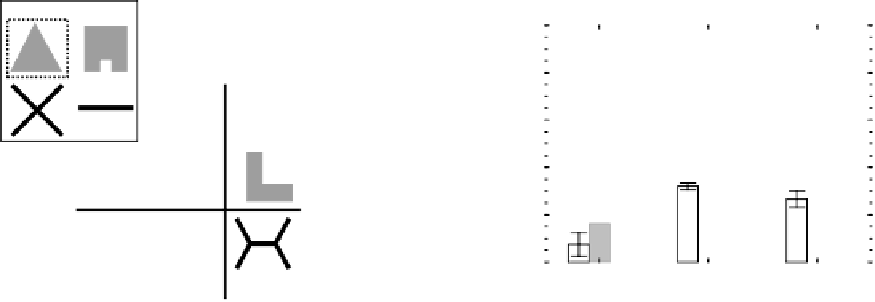Information Technology Reference
In-Depth Information
Perseverations from Frontal Lesions
Previous Stimuli
50
Rule Change
Control
Orbital
Lateral
Stimuli
40
Same
(Reversal)
Different
(Shift)
30
IDR
IDS
Intra−
dimensional
(ID)
20
Target
change
10
Extra−
dimensional
(ED)
0
IDS
IDR
EDS
EDR
EDS
Figure 11.11:
Perseverations from different types of frontal
lesions in the WCST-like task studied by Dias et al. (1997).
Orbital lesions (ventromedial) selectively impair intradimen-
sional (IDR) reversals, whereas lateral lesions selectively im-
pair extradimensional shifts (EDS, which are actually rever-
sals to a previously ignored dimension). Intradimensional
shifts (IDS) are never impaired. Data from Dias et al. (1997).
Figure 11.10:
Types of changes in categorization rule
following criterion performance on the original rule (fig-
ure 11.9), organized by same versus different stimuli across
the rule change, and intradimensional or extradimensional tar-
get change. The target stimulus is again indicated by the sur-
rounding box.
In this task, two stimuli are presented on each trial
(figure 11.9), and the subject is rewarded for choosing
the target stimulus. Each stimulus varies among two di-
mensions (e.g., filled-shape and line-shape), with each
dimension having two different possible features (e.g.,
within line-shapes, either a bar or an X). The target is
determined by one feature from one dimension (e.g., the
triangle feature from the filled-shape dimension). Thus,
reward is initially ambiguous between the two features
of the stimulus on the rewarded side. Then, the pattern
of reward across trials specifies the single target feature.
After the subject has achieved criterion level perfor-
mance (e.g., 90% correct), the target feature is changed,
and the stimuli either change or remain the same (fig-
ure 11.10). The target feature is changed either to a
feature within the same dimension (
intradimensional
,
or ID), or to a feature in the other dimension (
extradi-
mensional
, or ED). The stimuli either stay the same, or
they are changed such that each dimension (filled-shape
or line-shape) now has two new possible features.
When the stimuli remain the same, the rule change
results in a
reversal
, because the selection of a previ-
ously rewarded feature must be reversed to become a
nonselection, and the nonselection of a previously un-
rewarded feature must be reversed to become a selec-
tion. When the stimuli change, the rule change results
in a
shift
, because the selection of a previously rewarded
feature must be shifted onto a novel feature. Thus, there
are four different types of changes to the categorization
rule: intradimensional reversal (IDR), intradimensional
shift (IDS), extradimensional reversal (EDR), and ex-
tradimensional shift (EDS). The EDS case involves a
reversal at the dimensional level, because a previously
irrelevant dimension must be reversed to become rele-
vant, and a previously relevant dimension must be re-
versed to become irrelevant.
Dias et al. (1997) tested marmosets (a type of Old
World monkey) with lesions in different regions of
frontal cortex on three of these changes: IDR, IDS, and
EDS. They found selective impairment of intradimen-
sional reversals with orbital (ventromedial) lesions, se-
lective impairment of extradimensional shift with dor-
solateral lesions, and no significant impairments on
intradimensional shifts with either frontal lesion (fig-
ure 11.11).
Dias et al. (1997) interpreted their data in terms of
the inhibitory roles of both orbital and dorsolateral ar-
eas, because frontal effects are only seen when the tar-
get change is a reversal (either IDR or EDS). Presum-





Search WWH ::

Custom Search